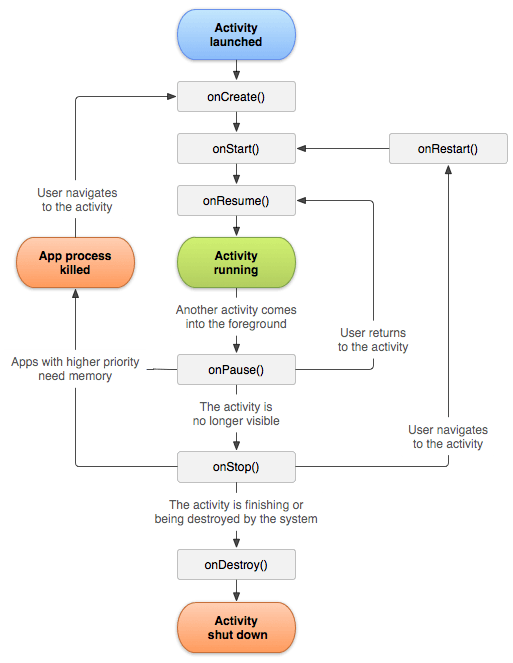Activities in the system are managed as an activity stack. When a new activity is started, it is placed on the top of the stack and becomes the running activity — the previous activity always remains below it in the stack. An activity can have following lifcycle :-
- The entire lifetime of an activity happens between the first call to
onCreate()through to a single final call toonDestroy(). An activity will do all setup of “global” state in onCreate(), and release all remaining resources in onDestroy(). For example, if it has a thread running in the background to download data from the network, it may create that thread in onCreate() and then stop the thread in onDestroy() - If an activity is in the foreground of the screen (at the top of the stack), it is active or running. The foreground lifetime of an activity happens between a call to
onResume()until a corresponding call toonPause(). During this time the activity is in front of all other activities and interacting with the user. - If an activity has lost focus but is still visible (that is, a new non-full-sized or transparent activity has focus on top of your activity), it is paused. A paused activity is completely alive (it maintains all state and member information and remains attached to the window manager), but can be killed by the system in extreme low memory situations. The visible lifetime of an activity happens between a call to
onStart()until a corresponding call toonStop(). During this time the user can see the activity on-screen, though it may not be in the foreground and interacting with the user. Between these two methods you can maintain resources that are needed to show the activity to the user. The onStart() and onStop() methods can be called multiple times, as the activity becomes visible and hidden to the user. - If an activity is completely obscured by another activity, it is stopped. It still retains all state and member information, however, it is no longer visible to the user so its window is hidden and it will often be killed by the system when memory is needed elsewhere.
- If an activity is paused or stopped, the system can drop the activity from memory by either asking it to finish, or simply killing its process. When it is displayed again to the user, it must be completely restarted and restored to its previous state.
The following diagram shows the important state paths of an Activity. The square rectangles represent callback methods you can implement to perform operations when the Activity moves between states. The colored ovals are major states the Activity can be in.

Source : Activity
